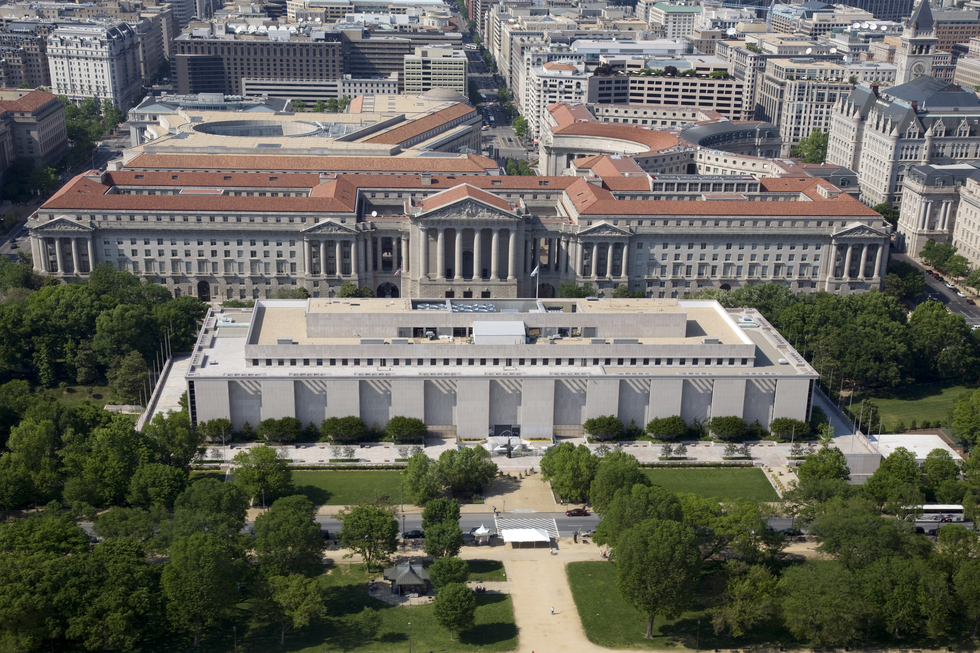This is a city that is rapidly taking its place as a cultural capital. Yes, New York City holds that title, but Washington may be catching up. It is home to the Smithsonian Institution, certainly the world’s most remarkable collection of museums. The “Nation’s Attic,” as it is sometimes called, preserves and displays a vast number of historical and cultural objects. But beyond the Smithsonian are a surprising number of topnotch art museum; historic homes that provide a wonderfully personal peephole into the past; and newer attractions that introduce visitors to the world of journalism, espionage and more. Go to Things to See for a full list of museums.
If you want to pop around and see the city's top museum treasures (not too difficult, as admission to most museums in this town is free), take a look at the following:
-
Declaration of Independence, one of the nation’s most cherished documents. National Archives.
-
Dorothy’s Ruby Red Slippers, a pair of the magical shoes worn by Judy Garland in Hollywood’s The Wizard of Oz. National Museum of American History.
-
First Folio of Shakespeare, an original copy of the first collected edition of the Bard’s work published in 1616. Folger Shakespeare Library.
-
George Washington by Gilbert Stuart, the Lansdowne portrait of 1796, generally regarded as the most famous portrait of Washington. National Portrait Gallery.
-
Ginevra de’ Benci, the only painting in the United States by the Florentine master Leonardo da Vinci. National Gallery of Art.
-
Gutenberg Bible of 1455, one of only three still-existing copies printed on hand-made parchment. Library of Congress.
-
Fence Rail from Bharhut, India: An exquisite relief carving from the second century, it’s one of the oldest and most intact Buddhist works in the world. Freer Gallery of Art.
-
Harmony in Blue and Gold: The Peacock Room, a complete room with floor-to-ceiling paintings by James McNeill Whistler. Freer Gallery of Art.
-
Hope Diamond, the legendary 45.5-caret bluish gem found in India in the 1600s. National Museum of Natural History.
-
Luncheon of the Boating Party by Renoir, one of the world’s most popular paintings. The Phillips Collection.
-
Moon Rock, a small, smooth slice of the moon astronauts brought home to earth. National Air and Space Museum.
-
Niagara by Frederic Edwin Church broke new ground in its use of perspective. It’s considered by many to be the supreme masterpiece of the Hudson Valley School of Painting. Corcoran Gallery.
-
Star-Spangled Banner, the War of 1812 flag that inspired America’s National Anthem. National Museum of American History.
-
Wright Flyer, the flimsy aircraft launched by Wilber and Orville Wright at Kitty Hawk in 1903 that inaugurated manned flights. National Air and Space Museum.
Museums in Anacostia
This historic, largely black residential neighborhood located east of the Capitol and away from the center of the city is not a typical tourist destination, but two attractions do draw visitors.
The Frederick Douglass National Historic Site (1411 W St. SE, at 14th St. SE; www.nps.gov/frdo; tel. 202/426-5961) is by far the more compelling. Born a slave in 1818, Frederick Bailey escaped his Maryland plantation, became an abolitionist and gifted orator, changed his name to Douglass to avoid capture, and fled to Britain, where he purchased his freedom. Back in the United States a free man, Douglass picked up where he had left off, fighting against slavery and for equal rights for all, including women. This house, known as Cedar Hill, was Douglass’s home for the last 17 years of his life. A National Park Service ranger begins your tour on the veranda, where you can see that the house crowns one of the highest hills in Washington. Then your guide takes you upstairs and down, filling you in on the life of the brilliant, brave, and charismatic abolitionist here at this house, and elsewhere: his love of reading, his escape from slavery, his married life, and his embrace of emancipation for all oppressed people.
See website for hours and admission, which is free, but by guided tour only. Tickets can be reserved in advanced for a $1 fee. Also see the African-American History itinerary.
The Anacostia Community Museum (1901 Fort Place SE, off Martin Luther King Jr. Ave.; www.anacostia.si.edu; 202/633-4820) is a Smithsonian museum that primarily serves the neighborhood and the local community with exhibits that resonate with area residents, focusing on social, cultural, and historical themes. As with all Smithsonians, admission is free. It’s open Tuesday through Saturday from 11am to 4pm.Note: This information was accurate when it was published, but can change without notice. Please be sure to confirm all rates and details directly with the companies in question before planning your trip.









